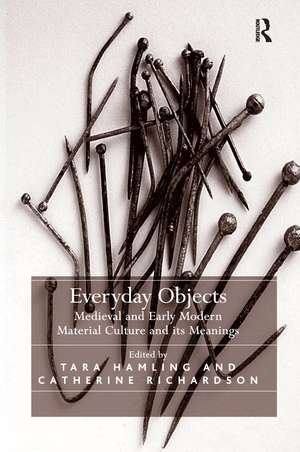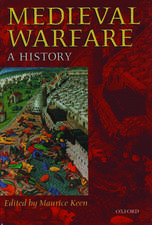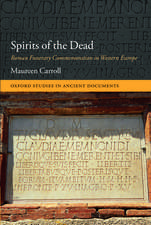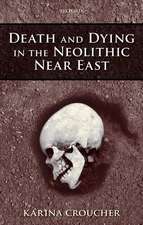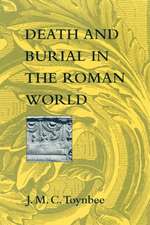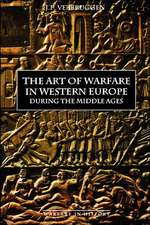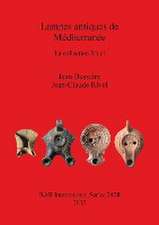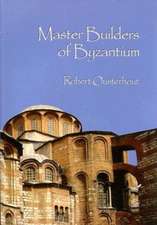Everyday Objects: Medieval and Early Modern Material Culture and its Meanings
Editat de Tara Hamling, Catherine Richardsonen Limba Engleză Hardback – 15 sep 2010
Preț: 1054.71 lei
Preț vechi: 1286.24 lei
-18% Nou
Puncte Express: 1582
Preț estimativ în valută:
201.84€ • 210.46$ • 167.75£
201.84€ • 210.46$ • 167.75£
Carte tipărită la comandă
Livrare economică 20 martie-03 aprilie
Preluare comenzi: 021 569.72.76
Specificații
ISBN-13: 9780754666370
ISBN-10: 0754666379
Pagini: 378
Dimensiuni: 156 x 234 x 30 mm
Greutate: 0.45 kg
Ediția:New.
Editura: Taylor & Francis
Colecția Routledge
Locul publicării:Oxford, United Kingdom
ISBN-10: 0754666379
Pagini: 378
Dimensiuni: 156 x 234 x 30 mm
Greutate: 0.45 kg
Ediția:New.
Editura: Taylor & Francis
Colecția Routledge
Locul publicării:Oxford, United Kingdom
Cuprins
Contents: Introduction, Tara Hamling and Catherine Richardson; Part I Evidence and Interpretation: 'For a crack or flaw despis'd': thinking about ceramic durability and the 'everyday' in late 17th- and early 18th-century England, Sara Pennell; The material culture of walking: spaces of methodologies in the long 18th century, Giorgio Riello; In the sight of an old pair of shoes, Stephen Kelly; Lexicological confusion and medieval clothing culture: redressing medieval dress with the Lexis of Cloth and Clothing in Britain project, Mark Chambers and Louise Sylvester. Part II Skills and Manufacture: Pins and aglets, Jenny Tiramani; Froes, rebatoes and other 'outlandish comodityes': weaving alien women's work into the fabric of early modern material culture, Natasha Korda; A shadow of a former self: analysis of an early 17th-century boy's doublet from Abingdon, Maria Hayward; Ordinary pots: the inventory of Francesco di Luca, Orciolaio, and Cipriano Piccolpasso's Three Books of the Art of the Potter, Steve Wharton. Part III Objects and Spaces: Archaeology of an age of print? Everyday objects in an age of transition, David Gaimster; The conservation of garments concealed within buildings as material culture in action, Dinah Eastrop; The enchantment of the familiar face: portraits as domestic objects in Elizabethan and Jacobean England, Tarnya Cooper; Faces and spaces: displaying the civic portrait in early modern England, Robert Tittler. Part IV Sound and Sensory Experience: Resurrecting forgotten sound: fans and handbells in early modern Italy, Flora Dennis; 'A potell of ayle on whyt Sonday': everyday objects and the musical culture of the post-Reformation English parish church, Jonathan Willis; Bagpipes and patterns of conformity in late medieval England, John J. Thompson. Part V Material Religion: Two texts and an image make an object: a devotional sheet from pre-Reformation England, R.N. Swanson; Contesting the everyday: the cultural biography of a subversive playing card, Richard L. Williams; Remembering the dead at dinner-time, Sheila Sweetinburgh; 'A table of alabaster with the story of the Doom': the religious objects and spaces of the Guild of Our Blessed Virgin, Boston (Lincs), Kate Giles. Part VI Attitudes towards Objects: 'A very fit hat'; personal objects and early modern affection, Catherine Richardson; Empty vessels, Lena Cowen Orlin; Objectification, identity and the late medieval Codex, Ryan Perry; Reconciling image and object: religious imagery in Protestant interior decoration, Tara Hamling; Index.
Notă biografică
Tara Hamling is RCUK Research Fellow in the Department of History at the University of Birmingham, UK. Catherine Richardson is Director of the Canterbury Centre for Medieval and Early Modern Studies and Senior Lecturer in Renaissance Literature at the University of Kent, UK.
Recenzii
'This research represents an important step toward the further affirmation of material culture studies... It also has potential to benefit other fields greatly and is a "must read" for students of medieval and early-modern history and culture’ - Journal of Folklore Research
'In sum, this lively and informative volume offers a series of swift sketches of objects in everyday life’ - Journal of British Studies
'... this is a remarkably coherent and fulsome collection that has something for anyone interested in this field’ - Sixteenth Century Journal
'The book will [...] be of great interest to anyone working at the cusp of the Middle Ages and the early modern era, but it also has much to draw the attention of other medievalists, particularly in terms of methodology... this book should attract the attention of scholars interested in material culture in any period or place’ - The Medieval Review
'Overall, the essays are engaging and thought-provoking, examining a wide range of objects and the functions, attitudes and ideas related to them’ - Material Religion
'The information that this collection provides restores some of the luster and meaning to goods that once stood in the chests, sideboards, and wardrobes of medieval and early modern households. The editors have done an excellent job of making sense of this highly diverse but always fascinating material world’ - The Historian
'And so Everyday Objects, which has so ably and adroitly focused on the importance of things themselves (seeking to free them from the strictures and generalizations of established narratives and interpretations), invites us, by its very success in doing what it intended, to acknowledge and more amply explore the historical condition of being as, in large part, the act of having and living by’ - Journal of Social History
'In sum, this lively and informative volume offers a series of swift sketches of objects in everyday life’ - Journal of British Studies
'... this is a remarkably coherent and fulsome collection that has something for anyone interested in this field’ - Sixteenth Century Journal
'The book will [...] be of great interest to anyone working at the cusp of the Middle Ages and the early modern era, but it also has much to draw the attention of other medievalists, particularly in terms of methodology... this book should attract the attention of scholars interested in material culture in any period or place’ - The Medieval Review
'Overall, the essays are engaging and thought-provoking, examining a wide range of objects and the functions, attitudes and ideas related to them’ - Material Religion
'The information that this collection provides restores some of the luster and meaning to goods that once stood in the chests, sideboards, and wardrobes of medieval and early modern households. The editors have done an excellent job of making sense of this highly diverse but always fascinating material world’ - The Historian
'And so Everyday Objects, which has so ably and adroitly focused on the importance of things themselves (seeking to free them from the strictures and generalizations of established narratives and interpretations), invites us, by its very success in doing what it intended, to acknowledge and more amply explore the historical condition of being as, in large part, the act of having and living by’ - Journal of Social History
Descriere
Material culture research has become an increasingly important aspect of the study of medieval and early modern societies, yet its study often remains uncoordinated and confined to narrow subject specific boundaries. As such, scholars will welcome this volume which provides an overview of various methodological strands currently developing across a range of disciplines. Taking a refreshingly broad approach, the collection explores 'everyday objects' as a way of questioning the relationship between material culture and historical themes. In so doing it highlights the way in which the study of objects can provide unexpected access to the 'lived experience' of individuals who may otherwise have left little impact in the written records.
